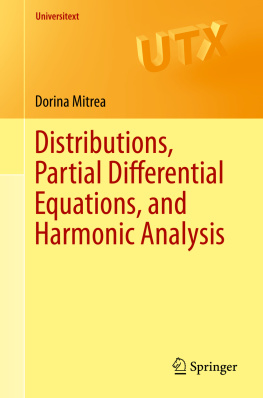SCHAUM'S OUTLINE OF
Theory and Problems of
STATISTICS
SCHAUM'S OUTLINE OF
Theory and Problems of
STATISTICS
Fourth Edition

MURRAY R. SPIEGEL, Ph.D.
Former Professor and Chairman
Mathematics Department, Rensselaer Polytechnic Institute
Hartford Graduate Center
LARRY J. STEPHENS, Ph.D.
Full Professor
Mathematics Department
University of Nebraska at Omaha


The late MURRAY R. SPIEGEL received the M.S. degree in Physics and the Ph.D. in Mathematics from Cornell University. He had positions at Harvard University, Columbia University, Oak Ridge, and Rensselaer Polytechnic Institute, and served as a mathematical consultant at several large companies. His last position was Professor and Chairman of Mathematics at the Rensselaer Polytechnic Institute, Hartford Graduate Center. He was interested in most branches of mathematics, especially those involving applications to physics and engineering problems. He was the author of numerous journal articles and 14 books on various topics in mathematics.
LARRY J. STEPHENS is Professor of Mathematics at the University of Nebraska at Omaha, where he has taught since 1974. He has also taught at the University of Arizona, Gonzaga University, and Oklahoma State University. He has worked for NASA, Lawrence Berkeley National Laboratory, and Los Alamos National Laboratory. He has consulted widely, and spent 10 years as a consultant and conducted seminars for the engineering group at 3M in Valley, Nebraska. Dr. Stephens has over 35 years of experience teaching statistical methodology, engineering statistics, and mathematical statistics. He has over 50 publications in professional journals, and has written books in the Schaum's Outline Series as well as books in the Utterly Confused and Demysti.ed series published by McGraw-Hill.

Copyright 2008, 1999, 1988, 1961 by The McGraw-Hill Companies, Inc. All rights reserved. Manufactured in the United States of America. Except as permitted under the United States Copyright Act of 1976, no part of this publication may be reproduced or distributed in any form or by any means, or stored in a database or retrieval system, without the prior written permission of the publisher.
0071594469
The material in this eBook also appears in the print version of this title: 0-07-148584-8.
All trademarks are trademarks of their respective owners. Rather than put a trademark symbol after every occurrence of a trademarked name, we use names in an editorial fashion only, and to the benefit of the trademark owner, with no intention of infringement of the trademark. Where such designations appear in this book, they have been printed with initial caps.
McGraw-Hill eBooks are available at special quantity discounts to use as premiums and sales promotions, or for use in corporate training programs. For more information, please contact George Hoare, Special Sales, at george_hoare@mcgraw-hill.com or (212)904-4069.
TERMS OF USE
This is a copyrighted work and The McGraw-Hill Companies, Inc. ("McGraw-Hill") and its licensors reserve all rights in and to the work. Use of this work is subject to these terms. Except as permitted under the Copyright Act of 1976 and the right to store and retrieve one copy of the work, you may not decompile, disassemble, reverse engineer, reproduce, modify, create derivative works based upon, transmit, distribute, disseminate, sell, publish or sublicense the work or any part of it without McGraw-Hill's prior consent. You may use the work for your own noncommercial and personal use; any other use of the work is strictly prohibited. Your right to use the work may be terminated if you fail to comply with these terms.
THE WORK IS PROVIDED "AS IS." McGRAW-HILL AND ITS LICENSORS MAKE NO GUARANTEES OR WARRANTIES AS TO THE ACCURACY, ADEQUACY OR COMPLETENESS OF OR RESULTS TO BE OBTAINED FROM USING THE WORK, INCLUDING ANY INFORMATION THAT CAN BE ACCESSED THROUGH THE WORK VIA HYPERLINK OR OTHERWISE, AND EXPRESSLY DISCLAIM ANY WARRANTY, EXPRESS OR IMPLIED, INCLUDING BUT NOT LIMITED TO IMPLIED WARRANTIES OF MERCHANTABILITY OR FITNESS FOR A PARTICULAR PURPOSE. McGraw-Hill and its licensors do not warrant or guarantee that the functions contained in the work will meet your requirements or that its operation will be uninterrupted or error free. Neither McGraw-Hill nor its licensors shall be liable to you or anyone else for any inaccuracy, error or omission, regardless of cause, in the work or for any damages resulting therefrom. McGraw-Hill has no responsibility for the content of any information accessed through the work. Under no circumstances shall McGraw-Hill and/or its licensors be liable for any indirect, incidental, special, punitive, consequential or similar damages that result from the use of or inability to use the work, even if any of them has been advised of the possibility of such damages. This limitation of liability shall apply to any claim or cause whatsoever whether such claim or cause arises in contract, tort or otherwise.
DOI: 10.1036/0071485848

Want to learn more?
We hope you enjoy this McGraw-Hill eBook! If you'd like more information about this book, its author, or related books and websites, please .
To the memory of my Mother and Father, Rosie and Johnie Stephens
L.J.S.
PREFACE TO THE FOURTH EDITION
This fourth edition, completed in 2007, contains new examples, 130 new figures, and output from five computer software packages representative of the hundreds or perhaps thousands of computer software packages that are available for use in statistics. All figures in the third edition are replaced by new and sometimes different figures created by the five software packages: EXCEL, MINITAB, SAS, SPSS, and STATISTIX. My examples were greatly influenced by USA Today as I put the book together. This newspaper is a great source of current uses and examples in statistics.
Other changes in the book include the following.. The answers to the supplementary problems at the end of each chapter are given in more detail. More discussion and use of p-values is included throughout the book.
ACKNOWLEDGMENTS
As the statistical software plays such an important role in the book, I would like to thank the following people and companies for the right to use their software.
MINITAB: Ms. Laura Brown, Coordinator of the Author Assistance Program, Minitab Inc., 1829 Pine Hall Road, State College, PA 16801. I am a member of the author assistance program that Minitab sponsors. "Portions of the input and output contained in this publication/book are printed with the permission of Minitab Inc. All material remains the exclusive property and copyright of Minitab Inc. All rights reserved." The web address for Minitab is www.minitab.com .
SAS: Ms. Sandy Varner, Marketing Operations Manager, SAS Publishing, Cary, NC. "Created with SAS software. Copyright 2006. SAS Institute Inc., Cary, NC, USA. All rights reserved. Reproduced with permission of SAS Institute Inc., Cary, NC." I quote from the Website: "SAS is the leader in business intelligence software and services. Over its 30 years, SAS has grownfrom seven employees to nearly 10,000 worldwide, from a few customer sites to more than 40,000and has been profitable every year." The web address for SAS is www.sas.com .
Next page













